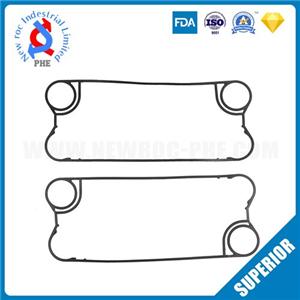Sealing rubber gasket for plate heat exchanger
The sealing rubber gasket of the plate heat exchanger is a key component in the heat exchange equipment. The working temperature of the plate heat exchanger is the temperature of the gasket, and the working pressure is also restricted by the gasket. The sealing gasket not only seals the heat exchange medium so that it does not leak to the outside, but also prevents the mutual liquid between the materials. In addition, the sealing rubber pad is also a kind of easy embrittlement part under natural conditions. If the gasket is hardened and loses its original ductility, the plate heat exchanger may not work properly.
1. The fixing form of the gasket of the plate heat exchanger:
Under normal circumstances, the fixing forms of heat exchanger gaskets are divided into three types: paste type, inlaid type and snap-fit type. The sealing gasket and the plate sealing groove of the plate heat exchanger must be completely consistent to achieve the sealing effect.
(1) Paste type: After applying sealant on the gasket groove, stick it directly into the installation groove of the heat exchange plate.
(2) Mosaic type: assembly holes are designed on the heat exchanger plate, and rubber nails are designed on the side of the sealing gasket. After the sealing gasket is put into the sealing groove, the rubber nails are inlaid in the assembly hole.
(3) Shelf type: a mountain-shaped buckle is designed on the side of the sealing gasket, and the sealing gasket is buckled on the heat exchange plate with the buckle nail.
2. Material and application of sealing rubber gasket for plate heat exchanger
(1) Nitrile rubber NBR: -10~110℃, suitable for water, sea water, mineral oil, salt water and other media;
(2) EPDM: -25~150℃, suitable for hot water, steam, acid, alkali and other media;
(3) Fluorine rubber FKM: -5~180℃, suitable for acid, alkali and other media;
(4) Tetrapropylene fluorine rubber: 0~160℃, suitable for medium such as concentrated acid, alkali, high temperature oil, steam, etc.;
(5) Hydrogenated nitrile nitrile HNBR: -10~140℃, suitable for high temperature mineral oil, high temperature water and nitrile rubber.
3. Removal and replacement of sealing gaskets
(1) Remove the waste heat exchanger gasket. Note that when disassembling, there must be no scratches in the gasket groove of the heat exchanger plate.
(2) Use acetone, methyl ethyl ketone or other ketone solvents to remove the residual glue in the gasket groove of the heat exchanger plate.
(3) Clean the gasket groove of the heat exchanger plate and the heat exchanger gasket with a clean cloth or cotton yarn.
(4) Spread the adhesive evenly in the gasket groove.
(5) Install a clean new heat exchanger gasket on the board.
(6) The heat exchanger plate with the heat exchanger gasket installed should be placed in a flat, cool and ventilated place before it can be installed and used after natural drying.




